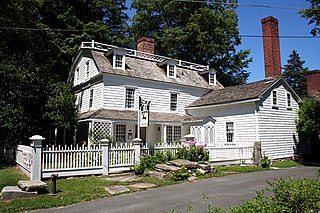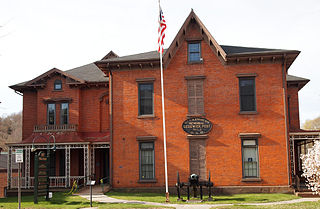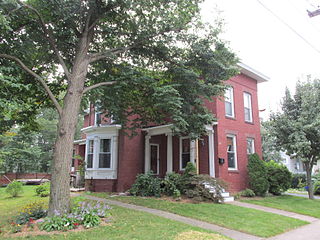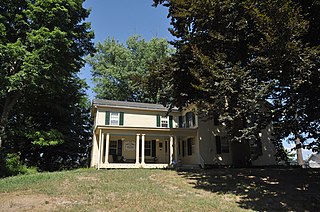
The Keeler Tavern is an 18th-century historical building at 132 Main Street in the center of Ridgefield, Connecticut, United States. The property served as summer home to architect Cass Gilbert, who purchased it in 1907 and designed additions to the building as well as a garden.

The Benninghofen House is a historic residence in Hamilton, Ohio, United States. Constructed in the 1860s, this house has been named a historic site for its high-quality architecture. Once the home of prominent Hamilton residents, it has been converted into a museum.

The John Rider House is located on Main Street in Danbury, Connecticut, United States. It is a wooden frame house dating to the late 18th century.

The Nathan and Mary (Polly) Johnson properties are a National Historic Landmark at 17–19 and 21 Seventh Street in New Bedford, Massachusetts. Originally two structures, one dating to the 1820s and an 1857 house joined with the older one shortly after construction. They have since been restored and now house the New Bedford Historical Society. The two properties are significant for their association with leading members of the abolitionist movement in Massachusetts, and as the only surviving residence in New Bedford of Frederick Douglass. Nathan and Polly Johnson were free African-Americans who are known to have sheltered escaped slaves using the Underground Railroad from 1822 on. Both were also successful in local business; Nathan as a [caterer] and Polly as a confectioner.

The former Grace Church Rectory is a historic church rectory and house at 301 Broad Street in Windsor, Connecticut. Built about 1865, it is a good local example of Gothic Revival architecture executed in brick. It was listed the National Register of Historic Places in 1988.

The Fyler–Hotchkiss Estate, also known as the Hotchkiss-Fyler House Museum, is a historic house museum at 192 Main Street in Torrington, Connecticut. Operated by the Torrington Historical Society, its main house is a well-preserved and distinctive example of Chateauesque Victorian architecture. It is also significant for its association with Orsamus Fyler, a prominent local politician and businessman. The property was listed on the National Register of Historic Places in 2009.

The Caleb Baldwin Tavern is a historic house at 32 Main Street in the Newtown Borough Historic District, located in Newtown, Connecticut, United States. Built c. 1763, the two-and-a-half-story house it is considered historically significant for its role in movement of French forces of Rochambeau, in which the building housed some of the army's officers in June 1781, en route to the Siege of Yorktown. It also an example of traditional 18th-century New England architecture, and retains some details from that time period. It was individually listed on the National Register of Historic Places on August 23, 2002.

The Benjamin Franklin Coppess House, built in 1882, is a historic Queen Anne and Stick-Eastlake style house located at 209 Washington Street in Greenville, Ohio, United States.

The William A. Buckingham House, also known as Buckingham Memorial Hall, is a historic house a fraternal hall at 307 Main Street in Norwich, Connecticut. It was built in 1847 by William A. Buckingham, whose later political career included terms as mayor of Norwich and Governor of Connecticut. Since 1898, it has housed a variety of veterans' and other service organizations, as well as government offices. The house was listed on the National Register of Historic Places on April 29, 1982.

The Charles Ives House, also known as Charles Ives Birthplace, is located on Mountainville Avenue in Danbury, Connecticut, United States. It is a wooden frame structure built in 1780 and expanded on since. Over the course of the 19th century it was the residence of several generations of Iveses, a family important in the city's history. In 1874 it was the birthplace of Charles Ives, who became an internationally recognized composer in the early 20th century.

The North Grove Street Historic District is located along the north end of that street in Tarrytown, New York, United States. It consists of five mid-19th century residences, on both sides of the street, and a carriage barn. In 1979 it was listed on the National Register of Historic Places.

The Whipple House is a historic house museum at 4 Pleasant Street in Ashland, New Hampshire. Built about 1837, it is a well-preserved example of a mid-19th century Cape-style house, that is relatively architecturally undistinguished. It is significant for its association with George Hoyt Whipple (1878–1976), a Nobel Prize-winning doctor and pathologist who was born here. Whipple gave the house to the town in 1970, and it is now operated by the Ashland Historical Society as a museum, open during the warmer months. The house was listed on the National Register of Historic Places in 1978.

The Enfield Town Meetinghouse is a historic Greek Revival style meeting house located on Enfield Street at South Road in Enfield, Connecticut. Completed in 1775 and moved and restyled in 1848, it hosted the municipal government until the 1920s. Now managed by the local historical society as a museum, it was listed on the National Register of Historic Places in 1974.

The Sharon Historic District encompasses the historic civic center of Sharon, Connecticut. Centered around a mile-long town green are an array of public civic and religious buildings, as well as residences from the 18th to 20th centuries. The area south of the green on South Main Street is lined with country houses developed or improved in the late 19th and early 20th centuries, representing one of the highest concentrations of Colonial Revival estates in the state. The district was listed on the National Register of Historic Places in 1993.

The Governor Smith Homestead is a historic house on South Main Street in Sharon, Connecticut. Built between 1765 and 1777, this large stone house has been a distinctive presence on the Sharon Green for over 200 years. It was for many years the home of John Cotton Smith, Governor of Connecticut during the War of 1812, and a nephew of the house's builder, Simeon Smith. The house was listed on the National Register of Historic Places in 1982, and was included in the Sharon Historic District in 1993.

The Selden Brewer House is a historic house at Naubuc Avenue and Main Street in East Hartford, Connecticut. Built about 1827, it is a good local example of late Federal/early Greek Revival architecture. It was built and owned for many years by a prominent local tobacco-growing family. Originally located on High Street, it was moved to its present location in the 1980s, and now houses offices of the local historical society. It was listed on the National Register of Historic Places in 1979.

111 Maple Street is a historic house in Windsor, Connecticut. Built about 1871, it is a good local example of Italianate architecture, with lingering Greek Revival touches. It was listed on the National Register of Historic Places in 1988.

The Isham-Terry House is a historic house museum at 211 High Street in Hartford, Connecticut. Built around 1854, from 1896 it was home to members of the Isham family, who restored it in the early 20th century. The family donated the property to Connecticut Landmarks in the 1970s, which now operates it has a museum, offering guided tours and facility event rentals. The house was listed on the National Register of Historic Places in 1982.

The Noden-Reed Museum is a historic house museum at 58 West Street in Windsor Locks, Connecticut. It includes the David Pinney House and Barn, and is a surviving reminder of the town's agricultural past. It is administered by the local historical society, and is listed on the National Register of Historic Places.

The Timothy Dwight Mills House is a historic house at 184 Deerfield Road in Windsor, Connecticut. Built about 1833, it is a well-preserved local example of transitional Federal/Greek Revival architecture executed in brick. It was listed on the National Register of Historic Places in 1988.






















